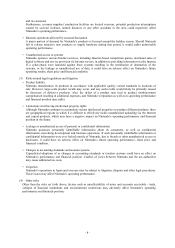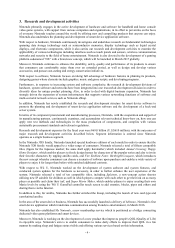Nintendo 2016 Annual Report Download - page 20
Download and view the complete annual report
Please find page 20 of the 2016 Nintendo annual report below. You can navigate through the pages in the report by either clicking on the pages listed below, or by using the keyword search tool below to find specific information within the annual report.- 18 -
(2) Company’s Systems and Policies
<System to ensure proper business execution>
1) System to ensure that the Company’s Directors and employees execute their duties in compliance
with the laws and regulations and the Articles of Incorporation
By establishing an Audit and Supervisory Committee which consists of a majority of Outside
Directors, the Company aims to strengthen the supervisory functions of the Board of Directors and
further promote corporate governance. Furthermore, the Company has established a compliance
program (legal risk management policy) to define normative systems for compliance and has
designed a compliance manual and otherwise implemented measures for promotion of compliance
through establishment of a Compliance Committee in order to ensure that Directors’ and
employees’ execution of duties complies with the laws and regulations and the Articles of
Incorporation. In addition, The Company has established a whistleblowing policy (“Compliance
Hotline”) for early discovery and correction of illegal conduct.
In addition to regular audits by the Audit and Supervisory Committee, the Internal Auditing
Department, under the direct supervision of the President, regularly evaluates whether the operation
of internal controls and financial reporting process of each division and department are appropriate
and effective through internal audits, and proposes and suggests measures to make improvements,
etc.
The Company has a system to deal with antisocial forces that threaten social order and security at
the company level, having appointed a responsible division for dealing with antisocial forces based
on its commitment to taking a tough stance against such forces. The Company has also built a
system to collaborate with police, attorneys and other outside expert organizations during ordinary
times to prepare for emergencies.
2) System for storage and management of information related to the execution of duties of the
Company’s Directors
The Company records information related to Directors’ execution of duties as minutes of
meetings of the Board of Directors, Executive Management Committee and other important
meetings, as well as documents such as action memos (including electronic records). Each such
record is stored and managed for an appropriate retention period, respectively, based on internal
regulations.
3) Regulations or any other systems of the Company for management of risk of loss
As a general rule, each division and department manages risks pertaining to work within its
jurisdiction. Furthermore, the Internal Auditing Department monitors the risk management system
of each division and department, and proposes and advises on policies for improvement, etc.
Further, under the Compliance Committee, thorough compliance efforts are promoted at each
division and department. In addition, the Company has established a Product Safety Committee and
other structures to guarantee product safety, prevent the occurrence of product accidents and ensure
prompt response in the event of an accident.
4) System to ensure that the execution of duties of the Company’s Directors is efficient
In addition to the meetings of the Board of Directors held monthly as a general rule, meetings of
the Executive Management Committee, which consists of all Directors (excluding Directors who
are Audit and Supervisory Committee Members), are held twice a month generally at the Company,
to make prompt and efficient decisions.
Furthermore, the Company has introduced the Executive Officer System for the purpose of
clarifying the responsibility for the execution of operations through the separation of the
management decision-making and supervisory functions from the execution of operations, as well
as by accelerating the delegation of authority to execute operations.
With regards to the execution of business based on decisions made by the Board of Directors or
the Executive Management Committee, internal regulations set forth the allocation of duties and
authorities to ensure organized and efficient operation of business.
5) System to ensure proper business execution within the Company group
The system seeks to ensure proper business execution within the Company group as a whole by
ensuring proper business execution by each subsidiary.
The Company has established internal regulations applicable to its subsidiaries mainly to ensure
efficient risk management and business operation by the subsidiaries. Pursuant to the regulations,
























